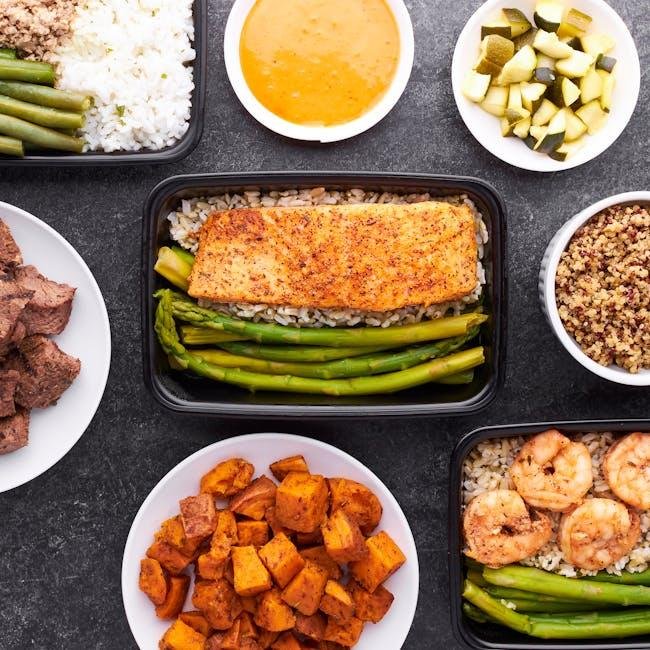In a world increasingly driven by health-conscious choices and dietary preferences, understanding the nutritional content of our food has never been more crucial, especially when it comes to the ubiquitous allure of fast food. While the convenience of a quick burger or fries ofen comes at the expense of clear nutritional labeling, there are ways to navigate these culinary landscapes without feeling lost.This article aims to arm you with the tools and techniques needed to estimate fast food macros—carbohydrates, proteins, and fats—without relying on food labels. From familiarizing yourself with common ingredient profiles to utilizing practical tips for portion control, we’ll explore how you can make informed choices while indulging in your favorite fast food meals. So, whether you’re on a quest for balance or simply curious about what’s in your meal, read on to learn the art of estimating macros in a way that’s both accessible and empowering.
Understanding Macronutrients in Fast Food Offerings
When seeking to understand the macronutrient composition of fast food without a label, it’s crucial to focus on the primary sources of calories: carbohydrates, proteins, and fats. Each component plays a vital role in our diet, and fast food is often a balanced medley of these macros. Some effective strategies to estimate these nutrients include:
- Visual Portion Sizes: Compare the size of your meal to familiar items. For example, a standard burger patty is roughly the size of a deck of cards.
- Ingredient Makeup: Consider the main ingredients. A burger will contain protein from the meat, fat from cheese, and carbohydrates from the bun.
- Fried vs. Grilled: Fried foods typically contain higher fat content; grilled items are generally lower in fats and higher in protein.
To simplify macro estimation, a general understanding of common fast food items can be beneficial.Below is a brief breakdown of typical macronutrient profiles for various fast food selections:
| Food Item | Calories | Protein (g) | Fat (g) | Carbs (g) |
|---|---|---|---|---|
| Burger | 250 | 12 | 15 | 25 |
| Chicken sandwich | 400 | 20 | 18 | 40 |
| Fries (Medium) | 350 | 4 | 17 | 54 |
| Salad with Dressing | 200 | 5 | 10 | 25 |

Decoding Portion Sizes: Visual Estimation Techniques
One effective approach to estimating portion sizes without nutritional labels is using everyday objects as visual cues. For example, a deck of cards can represent a palm-sized portion of protein, such as chicken or beef. Similarly, a tennis ball can help gauge the size of a medium serving of fruit. by associating food portions with familiar items, you can quickly assess how much you’re eating, making it easier to keep track of your macronutrient intake on the go. This technique is especially useful when navigating fast food choices where standard measurements are frequently enough absent.
To further enhance your estimation skills, consider utilizing finger measurements for smaller portions. for instance, your thumb can equal approximately one tablespoon of dressing or sauce, while a fist can be a rough estimate of a serving of vegetables. Practicing these visual estimations can lead to greater mindfulness in your eating habits and help you make more informed decisions, even in the whirlwind of fast food dining. Remember, incorporating these techniques into your daily meals can not only assist in macro tracking but can also promote healthier eating practices.

Utilizing Online Resources for Nutritional insights
In today’s digital age,obtaining nutritional information has become easier than ever,especially when it comes to estimating macronutrients for fast food meals. Numerous online resources provide insights that can definitely help you approximate the macros in your favorite fast food items. By leveraging nutrition databases, calorie counters, and mobile apps, you can access a wealth of knowledge right at your fingertips.Popular websites, such as MyFitnessPal or Calorielab, allow users to search for specific items and often include user-uploaded data that might not yet appear in manufacturer listings. Additionally, some fast-food chains offer nutritional info on their websites, which can be invaluable for making healthier choices on-the-go.
Another valuable technique involves searching for generic versions of meals.As a notable example, if you’re craving a burger from a popular chain, you can find similar items listed in nutritional databases that provide estimates for calories, protein, fats, and carbohydrates. Consider these steps when utilizing online resources:
- Search for the fast food item by name and look for reputable sources.
- Compare similar entries to account for any variations in recipe or portion size.
- Make use of food scales or measuring cups when possible to enhance accuracy.
don’t overlook online forums and communities where fitness enthusiasts share their experiences and insights. The knowledge gained from these discussions can provide valuable context and augment your understanding of nutritional values.

Smart Substitutions: Tweaking Your Meal for Better Balance
Finding healthier options at fast food restaurants doesn’t have to be a complex process. By making some smart substitutions, you can tweak your meal for a better balance of nutrients without sacrificing flavour. Consider opting for grilled instead of fried items to cut down on unhealthy fats. If you’re ordering a sandwich, you can request whole grain bread over white bread. Don’t forget to ask for extra vegetables—adding lettuce,tomatoes,and peppers increases fiber while adding minimal calories. You might also want to consider swapping sugary drinks for sparkling water or unsweetened iced tea. These small changes can considerably impact your meal’s overall macro balance.
Another effective strategy is to mimic the macro composition of your meal visually. Bring a mental picture of balanced food proportions: half your plate for vegetables or salad, a quarter for proteins, and a quarter for whole grains. You can imagine breaking down your meal into its components:
| Component | Macro Focus |
|---|---|
| Proteins | Opt for grilled chicken or turkey over beef |
| Carbohydrates | Choose whole grains like brown rice or whole wheat buns |
| Fats | Swap mayonnaise for mustard or avocado spreads |
| Dressings | Ask for dressing on the side and control portions |
Wrapping Up
In a world where convenience often comes with a side of uncertainty, understanding how to estimate fast food macros without a label can empower you to make more informed choices. By honing your observational skills and applying a little creativity with tools like smartphone apps and online databases, you can navigate the fast food landscape with confidence. Remember, while precise measurements are ideal, approximations can serve as a reliable compass when you’re on the go. Embrace the art of estimation, and transform your fast food excursions into opportunities for balance and mindful eating. with practise, you can savor the flavors you love while remaining in tune with your nutritional goals. So, the next time you’re faced with a drive-thru decision, remember: a little knowledge can go a long way.




